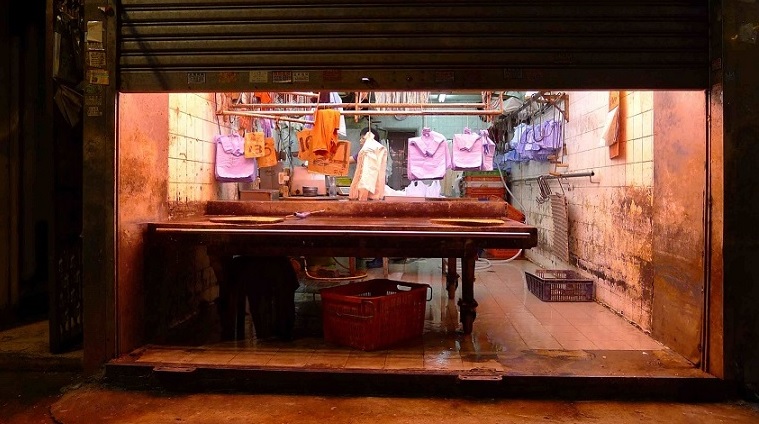藝評
照片意義 重新審視 ∣ Reassessing a Photograph
約翰百德 (John BATTEN)
at 2:42pm on 21st August 2017

圖片說明Caption:
2017年7月21日,香港深水埗的豬肉檔。
Butcher’s shop, Sham Shui Po, Hong Kong, 21 July 2017.
(Please scroll down for English version)
位於紐約的圖片社Magnum Photos偶爾會以優惠推廣旗下攝影師的方形照片。我最近便趁機購入了Stuart Franklin的經典《坦克人》*,即1989年6月4日在中國北京天安門,一名男士站在一列T59坦克車前,阻止它們前進的一幀作品。這幀照片所以廣為人知,因為它在解放軍部隊在天安門清場時,捕捉了一名手持購物袋的男子,隻身站在一列坦克車面前,當時包括Franklin在內的四位攝影師和CNN電視台的工作人員,正從北京飯店拍攝。
Franklin在自己的新著作《The Documentary Impulse》(紀錄的衝動)中,討論了紀錄攝影和《坦克人》的影像。在緊貼1989年6月4日後的幾天,世界各地報章出現的照片絕大部份都是解放軍部隊向學生開火又或死傷情況––呈現了天安門廣場持續數月的學生運動後的流血鎮壓。然而,Franklin提醒我們,自從「CNN (坦克人)的電視片段播出後,書報刊登的影像也發生了微妙的轉變。這些片段於6月4日被偷運出中國,最先於6月4日末至6月5日初由香港的媒體中心發出下鏈衛星訊號。據報其他歐美網絡錄低和播放了該段CNN衛星傳送。」到了6月6日,美聯社Jeff Widener和香港路透社曾顯華版本的「坦克人」照片發表,但只於數份主要西方報紙上現身,就是CNN電視片段有廣播的地方。
Franklin的影像,連同「多卷藏在一小盒茶葉裡的底片,翌日由一名法國學生從中國偷運境外,帶到巴黎」,送到Magnum的巴黎辦公室。 Franklin的坦克人照片到了6月19日才在《時代雜誌》跨頁刊登;與此同時,於1990年贏得世界年度新聞圖片獎的Charlie Cole版本也於《新聞週刊》發表。然而,在中國國內,新聞的焦點卻放在士兵的死亡,有些死於抗議學生的手中。
2009年,《紐約時報》首次刊登Terril Jones鏡頭下的坦克人,他在天安門學生抗議事件發生時,也是美聯社在北京工作的記者。由於美聯社當時已刊登Jeff Widener的照片,所以Jones的版本並沒有公之於世。Jones的照片與上述四款都不同,因為他當時在地面水平,在旁觀者爭相走避之間拍攝,而其他版本則是從北京飯店高空攝得。更重要的分別,這幅照片是其他版本較早時拍得的。
Jones的照片令故事更加深入,他解釋說:「……它讓我重新審視照片要告訴我們些什麼。我看到至今仍沒有人知道他是誰的男士,清楚地在坦克駛近他之前,已經預先想好。他沒有因為即將正面交鋒而跑掉……」這幅照片出色地顯示了坦克人冷静地站在長安街,等待向著他前來的坦克車駛到他面前。另外,Jones對坦克人有這樣的結論:「….他看似被逃命的人拋棄,也似乎是為其他逃命的人開路。」
《坦克人》的照片仍然是一幅充滿力量的影像。它刻劃了軍民敵對的場面,就像大衛與巨人歌利亞對峙,是大對小、弱對強,是國家對個別人民。
據Franklin所說,《坦克人》的照片所以成為經典,因為「它令影像具體化……令其從社會和政治環境中提煉出來。」《坦克人》的影像亦「模糊化了中國政府想要我們忘記的、更殘酷的大屠殺現實:輾過學生與單車、疊滿遺體的殮房……」另外,很不幸地,它也蓋過了我們腦中大部份紀錄這場於1989年瀰漫全中國的學生運動的其他攝影報導。
最近,我也花了少許時間重新審視一幀照片。某天我在黃昏時份走過深水埗,從一家豬肉檔半閉的大閘拍下了裡面發放出來的粉紅色光管光。後來我翻看這幅影像時,我發現香港有一個非常「仁慈」的習慣,就是以半閉鐵閘表示「我們已打烊 了」。但是,如果購物人士真的非常急需要買些什麼,店家可以酌情繼續服務。這種社會解說對於陳腔濫調地以粉紅色強光象徵血腥和暴力更具強而有力。
* 有關Stuart Franklin的《坦克人》照片,可瀏覽Magnum Photos官方網站: https://pro.magnumphotos.com/Package/29YL534Q87WO
原文刊於《明報周刊》,2017年8月5日。
Reassessing a Photograph
by John Batten
The New York-based Magnum Photos occasionally has a promotion offering square format photographs by its photographers. I recently bought from such a sale Stuart Franklin’s iconic “Tank Man” stopping a column of T59 tanks, Tiananmen Square, Beijing, China, June 4th 1989. * The photograph famously captures a man holding a pair of plastic shopping bags standing in front of a line of tanks close to the Beijing Hotel from which the image was taken by four photographers, including Franklin, and a CNN television crew, on the day that People’s Liberation Army troops cleared Tiananmen Square.
In Franklin’s recent book, The Documentary Impulse, he discusses documentary photography and the Tank Man image. In the immediate days after 4 June 1989 the photographs appearing in newspapers around the world were predominantly PLA troops shooting at students and of the dead – images depicting the bloody culmination of months of student protests in Tiananmen Square. However, Franklin reminds us that the published imagery subtly changed once “the CNN (Tank Man) television footage, smuggled out of China on 4 June, was first downlinked from Hong Kong’s Media Centre late on 4 June or early 5 June. Reportedly, other US and European networks recorded and broadcast the CNN satellite feed.” It was only then, on 6 June, that a Tank Man photograph, the versions by Jeff Widener of the Associated Press and Hong Kong’s Arthur Tsang Hin Wah of Reuters, were published – but, only in a handful of major Western newspapers where the CNN television footage had also been broadcast.
Franklin’s image was sent to Magnum’s Paris office amongst “rolls of film (that) were smuggled out of China the following day packed in a small box of tea and carried to Paris by a French student.” Franklin’s Tank Man photograph only appeared on 19 June in Time magazine as a double-page spread; at the same time as Charlie Cole’s version – which won the 1990 World Press Photo of the Year award – was published in Newsweek. In China, however, the news focused on the death of soldiers, some at the hands of protesting students.
In 2009, the New York Times published for the first time a photograph of Tank Man by Terril Jones, who had also been working as a reporter for the Associated Press in Beijing during the Tiananmen Square student protests. Jones did not make his own photograph public at the time as the Associated Press had already published Jeff Widener’s photograph. Jones’s photograph is different from the four other versions because it is taken at ground-level amongst fleeing bystanders, whereas all the others are from elevated positions inside the Beijing Hotel. And, significantly, it is taken moments before the others.
Jones’s photograph adds to the story, as he explains: “…this has led me to reassess what the photo tells us. I saw that the still-unidentified man clearly premeditated his stand well before the tanks were upon him; he didn’t dart out for the confrontation moments before….” His photograph shows the Tank Man, remarkably, standing in the middle of Chang’an Avenue calmly waiting for the approaching tanks to reach him. Furthermore, concluded Jones, the Tank Man “…appears to be abandoned by those running for cover, yet he also seems to be clearing a path for them to do so.”
The Tank Man photograph remains a powerful image. It depicts military against civilian. It is David versus Goliath. It is big versus small. It is weak versus strong. It is the state versus the individual.
The Tank Man photographs have become so iconic that, as Franklin notes, “it reifies the image…, abstracting it from its social and political context.” The Tank Man image “has had the effect of obscuring the harsher realities of the Beijing massacre that the Chinese government would want us to forget: the crushing of students and bicycles, the morgues piled high with bodies.…” It also, unfortunately, overwhelms and has displaced in our mind much of the other photojournalism that documented the 1989 student protests throughout China.
Recently, I also had a minor moment of reassessing a photograph. While walking around Sham Shui Po in the early evening, I photographed the strong pink fluorescent light coming from under a half-closed shutter of a butcher’s shop. Later, when I reconsidered the image, I realized that there is something remarkably ‘kind’ about the Hong Kong habit of half closing a shop’s shutter to say “we are closed”; but, if a shopper is really desperate to buy something, the shopkeeper can use their discretion to be open. This social commentary was more compelling than the initial attraction of the strong pink light as a clichéd symbol of blood or of implied violence.
* Stuart Franklin's 'Tank Man' photograph can be seen on the Magnum Photos website: https://pro.magnumphotos.com/Package/29YL534Q87WO
This article was originally published in 'Ming Pao Weekly', 5 August 2017.
